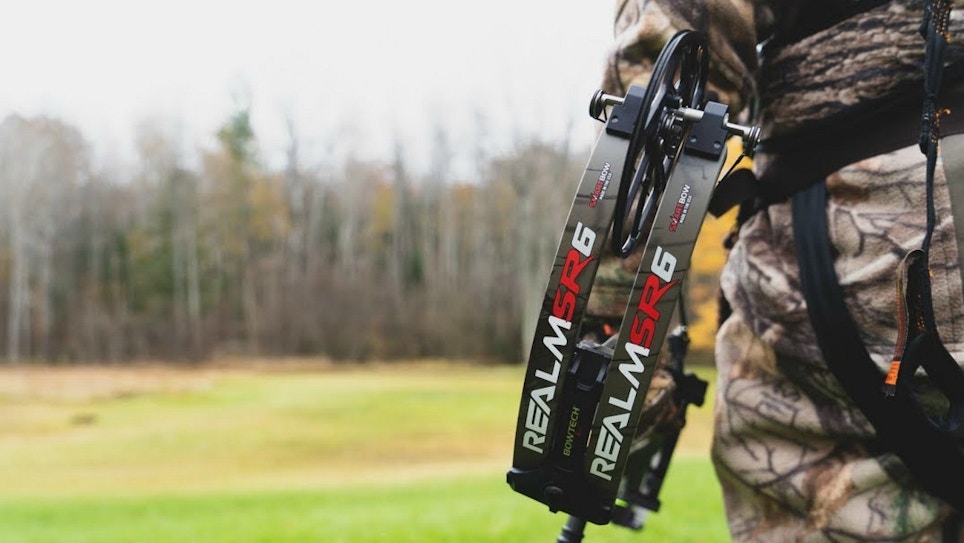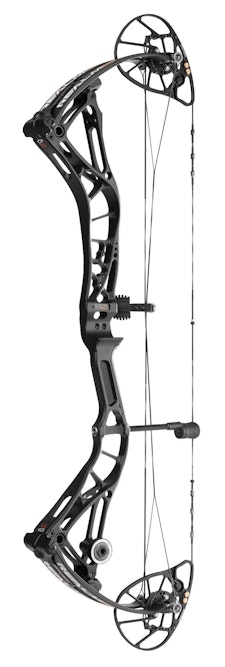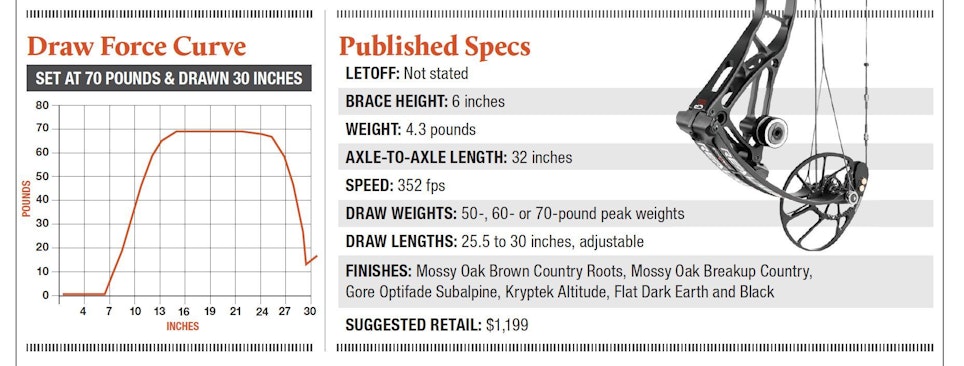Bowtech introduced the Realm series last year in the form of the Realm and the Realm X. For 2019 the series is expanded to include two more bows, the Realm SS (Super Smooth) and the faster Realm SR6. The SR is an acronym for Speed Redefined, with the 6 presumably representing the brace height. One of many bows touting a smooth draw cycle despite a high speed, there is no denying that with a nominal speed of 352 fps, the Realm SR6 is very fast. We’ll look at the speed-to-shootability ratio, but first let’s take a look at the technology common to the Realm series, as well as how Bowtech built on this technology to achieve a higher rate of speed.
At the core of the Realm series is Bowtech’s Overdrive Binary Cam System, which is a double-yoked design that slaves the cams together while at the same time offering a high degree of tunability. Instead of making increasingly minute adjustments to the rest, a shooter can twist or untwist one side or another of the yokes to in effect move the cam. The Realm bows also feature Bowtech’s Powershift Technology, enabling shooters to select between a Performance setting for higher speed, or a Comfort setting for a smoother draw cycle. This is accomplished by simply flipping a module over on each cam. It does affect the let-off slightly.
The solid-core limbs, famously tested to withstand 100,000 shot cycles, are relatively unchanged, and the new Realm bows also sport Bowtech’s zero-tolerance CP Dual Lock pocket. The slightly reflexed, slightly wider riser has been retained as well, caged top and bottom for enhanced stability. With an axle-to-axle of 32 inches, it’s a little longer than last year’s Realm, though not so long as the 33.25-inch Realm X. Also back are numerous threaded holes in various points on the riser allowing for the positioning of additional dampeners or weights to balance out a quiver or other accessories; the Orbit Dampener, also introduced last year, is located at the bottom of the riser and is itself threaded to allow stacking of additional dampeners or weights. Bowtech’s FLX Guard and the string stop make another appearance this year as well.
So what’s new, apart from the length of the riser? The cams have been modified, for one thing. They’re fairly aggressive, and weighted to eke out the last bit of efficiency. If you think of “efficiency” as speed, you’re only partially right. Increased efficiency can allow a bow to reach higher speeds without necessarily detracting from shootability. Or, looked at another way, it can allow a bow to be more pleasant-shooting without sacrificing speed. While not totally new, this year the Clutch Performance Grip offers options to customize color as well as grip style (high or low wrist, for instance). Last year I described that grip as close to no grip at all (while pointing out that it was ergonomic and comfortable), but the increased options available for this year will enable the shooter to make the bow accommodate his or her shooting form and personal preference, instead of the other way around.
Also new is that among the finish options this year is Mossy Oak Brown Country Roots. The test bow featured that pattern, and fit and finish passed the scratch test. Careful inspection revealed no machine marks or other flaws of any kind.
Shooting the Bowtech Realm SR6
There were no major hurdles in setting up the Realm SR6. The FLX Guard is positioned in such a way as to make installing our standard QAD rest with an arrow retainer a little awkward. Once it’s secured, positioning it is as simple as lining the arrow up with the two threaded holes for the rest, and using a straightedge or similar device to ensure that the arrow is equidistant from the front and rear of the riser. Limb bolts were very snug but turned smoothly without sticking or chattering. The bow comes set in the Performance mode, which is how I tested it. I did flip the modules and change the draw length to ensure it can be easily done. It isn’t difficult for anyone with a hex wrench set, but it’s not an operation you’d want to perform in the field. Do it over a clean, flat surface with good lighting or you’re sure to lose some tiny bolts or washers.
The draw cycle is, as touted, smooth, building to peak weight fairly rapidly. This is important, because it’s easier to pull weight at the beginning of the cycle, with the arm extended forward, than it is to pull the same amount of weight as the hand approaches a full draw position. A look at the draw force curves shows that peak weight plateaus for part of the cycle before dropping off quickly. The drop-off is fast, but does not result in any bumps or in an arm-wrenching stop at the back wall. The overall impression is, again, of remarkable smoothness, especially given the speed of the bow. The primary difference between the Realm SR6 and the Realm SS is that peak weight is not held for as long a portion of the draw cycle. That difference makes the SR6 faster, and the Realm SS a little smoother; a similar, though less dramatic, effect, is achieved by moving the SR6 from the Performance setting to the Comfort setting. The valley is a little shallow but not overly so. At the shot there is a small but detectable amount of vibration, though the SR6 is quieter than most bows of equal speed.
All in all, the SR6 fills out the Realm series nicely by offering more speed to shooters who desire it, while retaining the features that make the Realm bows highly accurate, extremely tunable and pleasant to shoot.
For more information, visit www.bowtecharchery.com.
How We Test
Each bow is carefully inspected out of the box for fit and finish and for any visible defects in workmanship. Axle-to-axle length, brace height, mass weight and draw length are measured and compared with stated specs. Minor discrepancies in draw length are corrected or noted. A QAD UltraRest is installed, and each bow is equipped with a TruGlo sight, a TruGlo stabilizer, a G5.25-inch Metapeep and a D-loop. Test arrows are Carbon Express Maxima Red arrows at weights of 385 and 440 grains, fletched with Bohning Blazer vanes and fitted with QAD Tune-A-Nocks. Peak draw weight is established, and draw force curves, along with letoff, are determined using an Easton Bow Force Mapping System.
Using a Spot-Hogg Hooter Shooter bow-shooting machine and a ProChrono chronograph, arrow speed and kinetic energy are measured at point of launch and at 20 yards.
Sound is measured with an NM102 Sound Level Meter with mic positioned 3 feet in front of the bow and 18 inches under the arrow flight path.
All bows are pressed on a Buckeye Archery Solutions Bow-A-Constrictor press.









